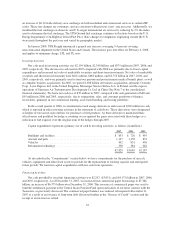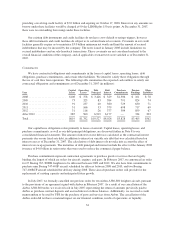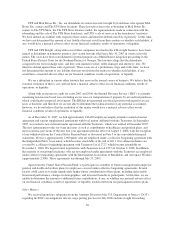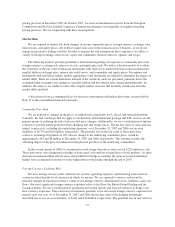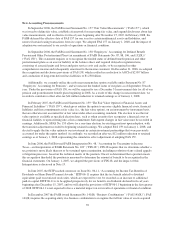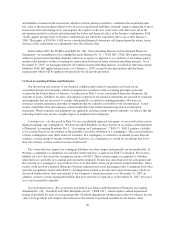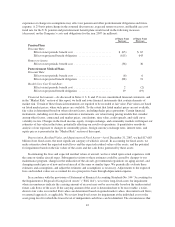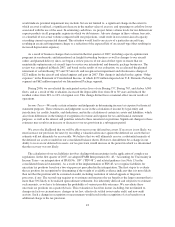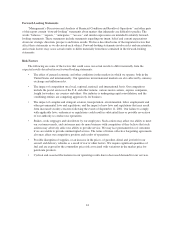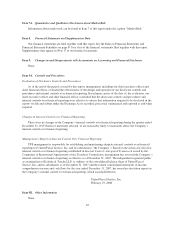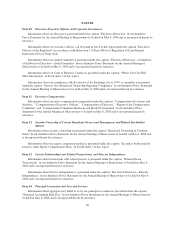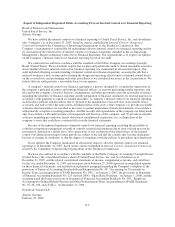UPS 2007 Annual Report Download - page 56
Download and view the complete annual report
Please find page 56 of the 2007 UPS annual report below. You can navigate through the pages in the report by either clicking on the pages listed below, or by using the keyword search tool below to find specific information within the annual report.We use a discounted cash flow model (“DCF model”) to estimate the fair value of our goodwill. The
completion of the DCF model requires that we make a number of significant assumptions to produce an estimate
of future cash flows. These assumptions include projections of future revenue, costs and working capital changes.
In addition, we make assumptions about the estimated cost of capital and other relevant variables, as required, in
estimating the fair value of our reporting units. The projections that we use in our DCF model are updated
annually and will change over time based on the historical performance and changing business conditions for
each of our reporting units.
As of December 31, 2007, our recorded goodwill was $2.577 billion, of which $2.282 billion relates to our
Supply Chain and Freight segment. This segment of our business has experienced rapid growth over the last
several years, largely due to the acquisitions that we have made. Because of its growth, this segment continues to
experience significant change as we integrate the acquired companies, resulting in higher volatility in our DCF
model projections than for our other segments. Our annual impairment tests performed in 2007, 2006 and 2005
resulted in no goodwill impairment.
Self-Insurance Accruals—We self-insure costs associated with workers’ compensation claims, automotive
liability, health and welfare, and general business liabilities, up to certain limits. Insurance reserves are
established for estimates of the loss that we will ultimately incur on reported claims, as well as estimates of
claims that have been incurred but not yet reported. Recorded balances are based on reserve levels, which
incorporate historical loss experience and judgments about the present and expected levels of cost per claim.
Trends in actual experience are a significant factor in the determination of such reserves. We believe our
estimated reserves for such claims are adequate, but actual experience in claim frequency and/or severity could
materially differ from our estimates and affect our results of operations.
Workers’ compensation, automobile liability and general liability insurance claims may take several years to
completely settle. Consequently, actuarial estimates are required to project the ultimate cost that will be incurred
to fully resolve the claims. A number of factors can affect the actual cost of a claim, including the length of time
the claim remains open, trends in health care costs and the results of related litigation. Furthermore, claims may
emerge in future years for events that occurred in a prior year at a rate that differs from previous actuarial
projections. Changes in state legislation with respect to workers compensation can affect the adequacy of our
self-insurance accruals. All of these factors can result in revisions to prior actuarial projections and produce a
material difference between estimated and actual operating results.
We sponsor a number of health and welfare insurance plans for our employees. These liabilities and related
expenses are based on estimates of the number of employees and eligible dependents covered under the plans,
anticipated medical usage by participants and overall trends in medical costs and inflation. Actual results may
differ from these estimates and, therefore, produce a material difference between estimated and actual operating
results.
Pension and Postretirement Medical Benefits—As discussed in Note 5 to our consolidated financial
statements, we maintain several defined benefit and postretirement benefit plans. Our pension and other
postretirement benefit costs are calculated using various actuarial assumptions and methodologies as prescribed
by Statement of Financial Accounting Standards No. 87, “Employers’ Accounting for Pensions” and Statement
of Financial Accounting Standards No. 106, “Employers’ Accounting for Postretirement Benefits Other than
Pensions.” These assumptions include discount rates, health care cost trend rates, inflation, rate of compensation
increases, expected return on plan assets, mortality rates, and other factors. Actual results that differ from our
assumptions are accumulated and amortized over future periods and, therefore, generally affect our recognized
expense and recorded obligation in such future periods. We believe that the assumptions utilized in recording the
obligations under our plans are reasonable based on information as to historical experience and performance as
well as other factors that might cause future expectations to differ from past trends. Differences in actual
41



